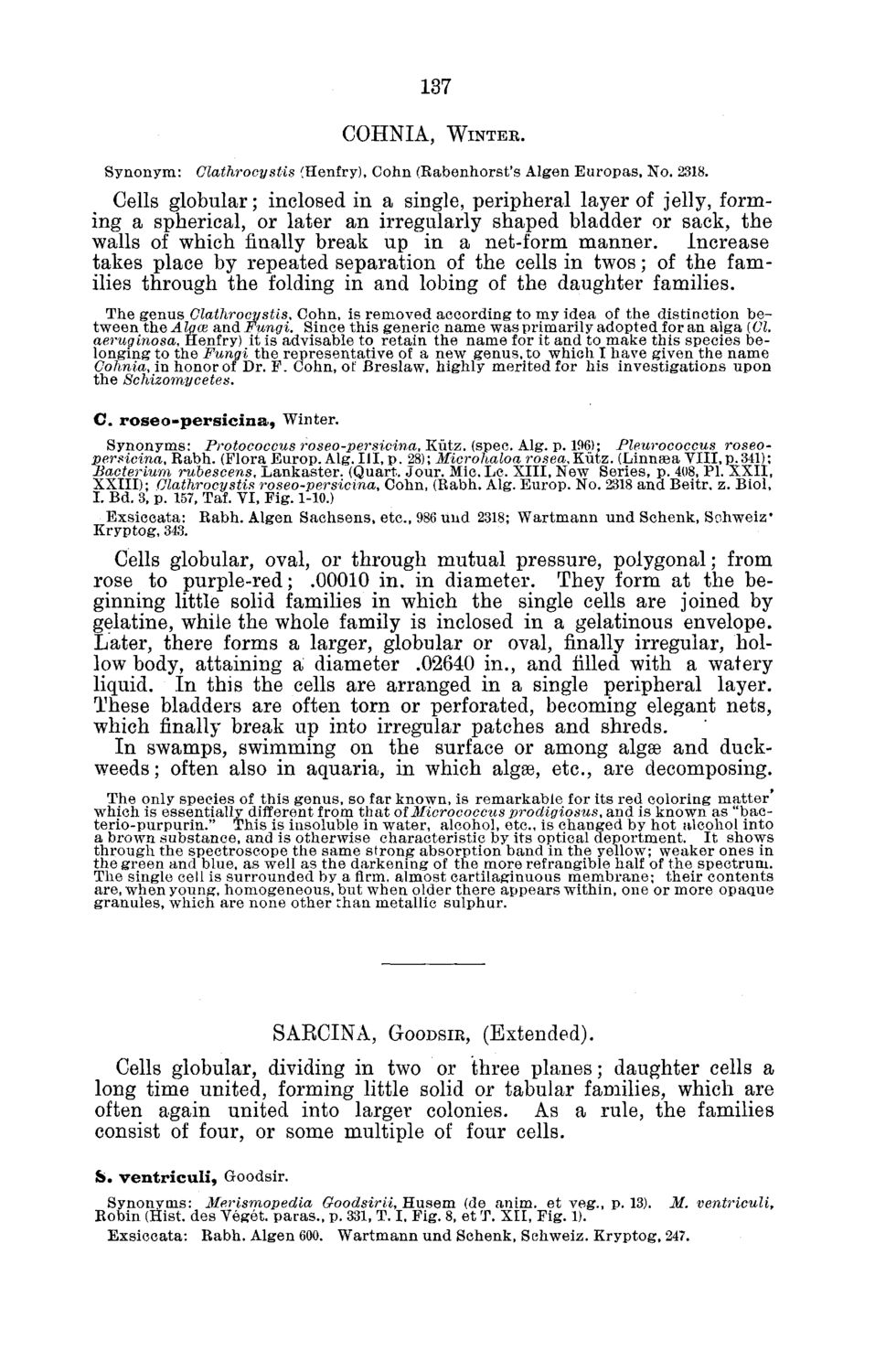| |
| |
Caption: Board of Trustees Minutes - 1882
This is a reduced-resolution page image for fast online browsing.

EXTRACTED TEXT FROM PAGE:
137 COHNIA, WINTER. Synonym: Clathrocystis {Henfry), Conn (Babenhorst's Algen Europas, No. 2318. Cells globular; inclosed in a single, peripheral layer of jelly, forming a spherical, or later an irregularly shaped bladder or sack, the walls of which finally break up in a net-form manner. Increase takes place by repeated separation of the cells in twos; of the families through the folding in and lobing of the daughter families. The genus Clathrocy stis. Conn, is removed according to my idea of the distinction between the Algce and Fungi. Since this generic name was primarily adopted for an alga {CI. aeruginosa, Henfry) it is advisable to retain the name for it and to make this species belonging to the Fungi the representative of a new genus, to which I have given the name Cohnia, in honor of Dr. F . Colin, of Breslaw, highly merited for his investigations upon the Schizomycetes. C. r o s e o - p e r s i c i n a , Winter. Synonyms: Protococcus roseo-persicina, Kiitz. (spec. Alg. p. 196); Pleurococcus roseopersicina, Rabh. (FloraEurop.Alg.IlI, p. 28); Microhaloa rosea,Kutz. (Linnaea VIII,p.34D; Bacterium rubescens, Lankaster. (Quart. Jour. Mic. Lc. XIII, New Series, p. 408, PL XXII, XXIII); Clathrocy stis roseo-persicina, Cohn, (Rabh. Alg. Europ. No. 2318 and Beitr. z. Biol, I. Bd. 3, p. 157, Taf. YI, Fig. 1-10.) Exsiccata: Rabh. Algen Sachsens, etc., 986 und 2318; Wartmann und Schenk, Sohweiz' Kryptog, 343. Cells globular, oval, or through mutual pressure, polygonal; from rose to purple-red; .00010 in. in diameter. They form at the beginning little solid families in which the single cells are joined by gelatine, while the whole family is inclosed in a gelatinous envelope. Later, there forms a larger, globular or oval, finally irregular, hollow body, attaining a diameter .02640 in., and rilled with a watery liquid. In this the cells are arranged in a single peripheral layer. These bladders are often torn or perforated, becoming elegant nets, which finally break up into irregular patches and shreds. In swamps, swimming on the surface or among algae and duckweeds; often also in aquaria, in which algse, etc., are decomposing. The only species of this genus, so far known, is remarkable for its red coloring matter which is essentially different from that of Micrococcus prodigiosus, and is known as "bacterio-purpurin." This is insoluble in water, alcohol, etc., is changed by hot alcohol into a brown substance, and is otherwise characteristic by its optical deportment. It shows through the spectroscope the same strong absorption band in the yellow; weaker ones in the green and blue, as well as the darkening of the more refrangible half of the spectrum. The single cell is surrounded by a firm, almost cartilaginuous membrane; their contents are, when young, homogeneous, but when older there appears within, one or more opaque granules, which are none other than metallic sulphur. SAECINA, GOODSIR, (Extended). Cells globular, dividing in two or three planes; daughter cells a long time united, forming little solid or tabular families, which are often again united into larger colonies. As a rule, the families consist of four, or some multiple of four cells. &• v e n t r i c u l i , Goodsir. Synonyms: Merismopedia Goodsirii, Husem (de anim. et veg., p. 13). M. ventriculi, Robin (Hist, des Veget. paras., p. 331, T. I, Fig. 8, et T. XII, Fig. 1). Exsiccata: Rabh. Algen 600. Wartmann und Schenk, Schweiz. Kryptog, 247.
| |